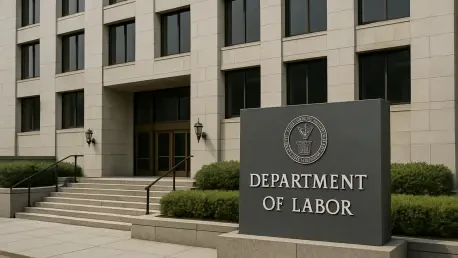In a rapidly changing economic and political landscape, the U.S. Occupational Safety and Health Administration (OSHA) faces a significant challenge in navigating budget cuts proposed by the Department of Labor (DOL). The efforts are led by Secretary Lori Chavez-DeRemer, who aims to adjust funding and workforce while ensuring worker safety. With the budget reduced from $632.3 million to $582.4 million and planned staff cuts from 1,810 to 1,587 full-time employees, Chavez-DeRemer assures that safety standards will not be compromised. This event acknowledges the pressures faced by OSHA in internal efficiency and external expectations, creating key debates about resource allocation and strategic direction.
Understanding the Proposed Budget Cuts
The proposed budget cuts set the stage for determining OSHA’s operational priorities, spearheaded by Secretary Lori Chavez-DeRemer’s fiscal approach. The adjustments suggest substantial changes, with reduced funding and staff, marking a pivotal point in OSHA’s capability to enforce safety standards comprehensively. Despite the financial constraints, Chavez-DeRemer’s strategic approach underscores modernization and efficiency improvements over traditional dependence on increased funding. This signifies a critical examination of OSHA’s role, focusing on maintaining safety performance amidst limited resources, reflecting broader governmental objectives.
The compelling need for adjustment stems from factors such as workforce efficacy challenges highlighted by U.S. Rep. Ilhan Omar, expressing concerns over inspection timelines and overall operational capacity. At the heart of these issues is the pursuit of an optimal balance between available resources and workplace safety regulations, resonating with political and economic imperatives. The urgency in realigning OSHA’s functions under fiscal scrutiny places the agency at the center of debates on maintaining comprehensive occupational safety measures, advocating for innovative solutions while adhering to regulatory standards.
Delving into Key Discussions and Insights
The event featured insightful discussions and debates focusing on the impact of budget constraints on OSHA’s operational efficiency and workforce capacity. The dialogues emphasized the importance of streamlining processes, reevaluating regulatory frameworks, and enhancing staff productivity to effectively manage current challenges. Expert opinions and detailed evaluations revealed critical factors influencing OSHA’s performance, urging recalibration of practices to align with fiscal realities.
Expert Opinions and Findings
Experts shared their findings, shedding light on potential pathways to maintain OSHA’s effectiveness despite funding changes. Discussions revolved around innovative approaches for optimizing procedural frameworks, with an emphasis on eliminating inefficiencies through modernization. This highlighted the need for strategic foresight in adapting to evolving economic conditions and maintaining high safety standards.
Conclusions reached at the event suggest interventions focusing on efficiency, deploying technology, and reassessing traditional operational models. Expert insights provided a roadmap for balancing the constraints against the essential mission of protecting workers. Such perspectives paved the way for constructive dialogue about the pragmatic execution of policies under tighter budgets.
Panel Discussions on Safety Regulations
Key themes emerged in panel discussions regarding OSHA’s role in adapting safety standards to meet both regional and federal requirements. Conversations included expert opinions exploring flexibility in regulations, especially concerning geographic differences such as the ongoing debate over the OSHA heat safety rule. These discussions highlighted potential opportunities for aligning standards to accommodate variability in environmental conditions across the nation.
Differences in viewpoints revealed a nuanced understanding of the intersection between resource availability and regulatory efficacy. The panels showcased the need for dynamic approaches to safety regulations, encouraging adaptations aligned with geographical considerations while adhering to core federal guidelines. Such efforts underline the critical balance between ensuring safety and meeting economic objectives.
Workshops and Interactive Sessions
Workshops and interactive segments provided participants with practical insights into modernization approaches and safety principles amid budget cuts. These activities fostered engagement, highlighting the importance of collective efforts in developing efficient practices and sustaining high safety standards without expanding resources excessively.
Through group activities and open discussions, the sessions created a platform for exchanging ideas and exploring innovative solutions to enhance workplace safety. Participants gained valuable experiences, focusing on effective strategies for modernizing safety protocols within budget limitations. Insights gathered through these workshops emphasized collaborative efforts for achieving optimized safety outcomes.
Innovations in Safety and Technology
The event featured exhibitions and product demonstrations showcasing technological advancements aimed at improving workplace safety under financial constraints. Notable innovations captured attendees’ attention, offering solutions to modern workplace challenges and highlighting their potential influence on OSHA’s future directives.
These showcases demonstrated technology’s transformative role in workplace safety, underscoring its importance in supporting OSHA’s mission. The innovations highlighted new ways to address critical safety issues through cost-effective methods, enabling a forward-looking approach to adapting regulatory functions amid constrained budgets.
Looking Forward: Future Implications and Industry Impact
Recapping key insights from the event, the discourse focused on the broader implications for OSHA and the industry moving forward. Participants examined the long-term effects on occupational safety due to budgetary changes, exploring potential trend shifts in industry standards and practices.
Deliberations underscored the necessity for harmonizing financial efficiency with comprehensive safety measures. Thought leaders outlined future considerations, emphasizing a strategic approach for aligning budget constraints with the imperatives of worker protection. These discussions highlighted a roadmap that paves the way for innovative practices in addressing the evolving landscape of occupational safety standards.









